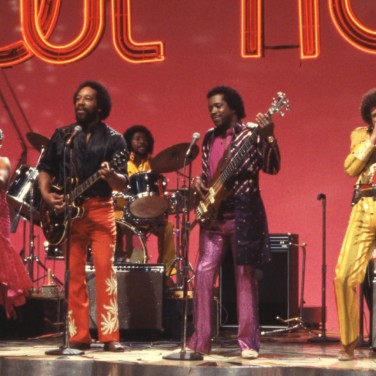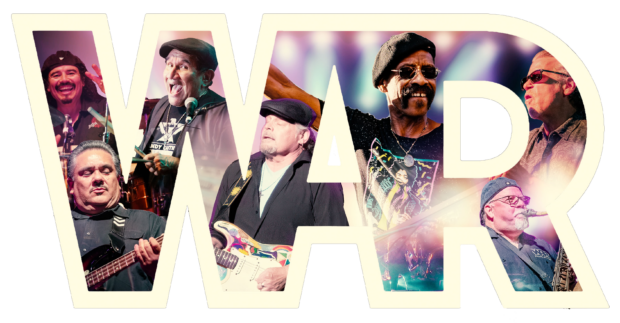
April 28, 2020
War Is Much Better Than Its Hits
In the ’70s, the hits of War were everywhere. From car radios, stereo systems and street parties poured songs like “Cisco Kid,” “Low Rider,” and “Why Can’t We Be Friends?,” hits that, together, helped define the decade. But in hindsight, War’s singles only gave a hint of the character and texture of their full albums. In fact, few bands experienced such a disconnect between the songs radio favored and their larger body of work.
War’s best-known songs were terse, catchy and fun, as all great singles should be. But their albums went another way, achieving something elaborate, challenging and deep. Where War’s hits had an accessibility that allowed them to reflect the life of anyone who listened, their albums spoke of specific lives that came from a particular sensibility and place.
The broad catalogue War created during their ’70s prime captured the essence of Los Angeles areas like Compton and Long Beach, places where many of the band’s members either grew up or moved to. The members also reflected the ethnicities in those areas, bringing together Latin, African-American and Caucasian players. In a parallel way, War’s sound combined Latin-jazz, funk, pop and rock. The amalgam arrived just as Afro-Cuban influences were enjoying a fresh surge in music, in acts from Santana and Malo to Mandrill and the Fania All-Stars. While all those groups had distinct sounds, War’s was, perhaps, the most finely-attuned to the groove.
Their deep tracks favored riffs that moved laterally, as an array of soloists took flight above. No fewer than four of their members improvised with distinction, including the Danish-born harmonica player Lee Oskar, sax and flute man Charles Miller, guitarist Howard Scott and keyboardist Lonnie Jordan. Providing their defining foundation was the three-way rhythm section, comprised of bassist B.B. Dickerson, drummer Harold Ray Brown and percussionist “Papa Dee” Allen. Though instrumental sections ate up huge chunks of War’s music, their approach to vocals also played a key role. All seven members sang, often in unison, giving their voices a purpose while simultaneously covering for a flaw. Though all the members had solid voices, none had the pre-eminence of the greatest front men. Singing together gave them extra power. More, their blend of voices gave the music the feel of a neighborhood in conversation. It was crowded and clamorous, but also convivial, lending the music a sense of community.
That vibe had great symbolic resonance in a place, and at a time, when gang-activity drove many locals apart. The music of War demonstrated the power of unity over division. Heard in that context, hits like “Why Can’t We Be Friends,” “Summer” and “Low Rider” became peace pipes, connecting the inner city, rather than mere party anthems for the suburbs. On the East Coast, the Latin-rock group The Ghetto Brothers served a similar purpose, but with a heightened sense of authority. The Brothers included in their ranks actual gang members who used their music to broker deals between rivals in a then burning Bronx.
Of course, the Ghetto Brothers never achieved anywhere near the exposure of War. But, in the ’70s, few groups did. During their prime, between 1970 and ’77, this West Coast colossus amassed no fewer than eight gold albums, as well as two platinum sets (both hits collections). They also enjoyed seven Top Ten Billboard singles; Twelve of their songs made the Top 40.
War scored its first chart smash—the Top Five “Spill the Wine”—before they even solidified as the group they would become. On their first two album, they backed a singer who was already a star, Eric Burdon of The Animals. The British-born vocalist, along with veteran producer Jerry Goldstein, discovered the musicians during a club show in L.A. and, afterwards, proposed a collaboration. The resulting collection, ‘Eric Burdon Declares War’, released in April of 1970, had the feel of a band finding its footing. But the looseness created its own distinction. The album consisted mainly of long, evolving jams. The seven-minute “Vision of Rassan” tipped a hat to avant-garde jazz player Rassan Roland Kirk, while the title of another piece, “Blues for Memphis Slim,” made its inspiration just as plain. Not that either song sounded like the music of the artists they name-dropped. Both stressed hard funk, created by the rhythm section, while the soloists riffed and Burdon offered his own mix of rapping and singing. It was a summery, loopy, and sexy sound, indulgent to be sure but with a real feel for the beat.
Their follow-up, released under the tongue-in-cheek title ‘The Black-Man’s Burdon’, offered unrecognizable improvisations on the Stones’ “Paint It Black” and the Moody Blues “Nights in White Satin.” A double set, ‘Burdon’ was even more undisciplined than its predecessor, but it had more speed and variety on its side. Though both albums made the Top Thirty, Burdon wound up ditching the group during a European tour, inadvertently freeing them to find their own voice.
The slimmed down group began clearing their throat on “War,” which appeared in the Spring of ’71. It offered a promising sampler of the array of styles they could command on their own. “Sun Oh Sun” with lead vocals from bassist Dickerson, contrasted two sections, a relaxed piece of pop, goosed by the fluttering flute of Miller, and a harder funk-rock rhythm, fired by a tough guitar and surging organ. “Lonely Feeling,” built on Jordan’s funky piano and sly vocal, had the kind of brisk New Orleans shuffle you’d expect from Allen Toussaint, while the thoughtful ballad “Back Home,” voiced by Miller, centered on his soulful sax. War’s deep influence from Latin-jazz showed in “War Drums,” highlighted by Allen’s barreling congas, but the group fell back into its indulgent side in the final, 11- minute piece, “Fidel’s Fantasy.” It centered on a taunting monologue from Allen that imagined a nightmarish fever dream of the Cuban dictator. While tedious as a whole, it did include striking, Afro-Cuban solos from Miller’s flute and Oskar’s harmonica.
Understandably, the album didn’t connect commercially, but War corrected that before the year was out with their follow-up, ‘All Day Music’. A more tuneful and focused work than their debut, War’s second, post-Burdon album proved they could channel deep grooves and instrumental stretches into songs that passed for pop. The title track, with its easy groove, warm harmonica and rich organ, sounded like an ideal song of summer, while the largely instrumental “Nappy Head” crossed the Latin beat of Steely Dan’s “Do It Again” with the loosey-goosey organ of “Spill the Wine.” For good measure, it featured a lovely jazz guitar line from Scott and a charging horn section. “Get Down” underscored War’s flair for New Orleans’ funk, while Scott’s hard guitar played hide and seek with Oskar’s sharp harmonica. Likewise, “That’s What Love Will Do” tapped sweet soul, laced by flute breaks from Miller. For even more variety, the album closed with a live track fired by the kind of boogie guitar you’d expect from ZZ Top. Even so, the break-out number turned out to be “Slippin’ Into Darkness,” a funky rewrite of Bob Marley’s “Get Up Stand Up,” that became War’s first post-Burdon hit. Its irresistible funk beat paved the way for the later pop crossovers of bands like Kool and the Gang and the Ohio Players. Memorable as the single version of “Slippin'” may have been, the full album recording is the one to hear. At twice the length, it demonstrated how War could hone a hit for radio, while preserving their freedom on album.
If “Slippin” got the band on the radio, their next album, ‘The World Is a Ghetto’, had a virtual stranglehold on it. Both the title track and the album’s opener, “Cisco Kid,” exploded, becoming not just hits but iconic recordings. The latter epitomized outlaw cool, presenting a fallen, inner city tough guy as a mythic bad-ass. The former made a political statement, asserting that we all live in ghettos, created by the ways we segregate ourselves from other cultures and classes. Musically, the push and pull between Latin congas, African horns and thumping funk bass in “Cisco Kid” made turned a quintessential urban tale into a universal dance anthem. But if the 3-minute single version of “Ghetto” enticed, the album take went farther, stretching into a ten-minute monster jam, elaborated by the explorative sax of Miller and the wah-wah lead guitar from Scott. The rest of the album suffered no filler, from the bouncy New Orleans funk-rocker “Where Was You At? to the searching, 13-minute instrumental “City, Country, City.” The latter interwove a warm harmonica, a hard funk guitar, some lush organ, as well as a searching sax solo. It even found room for a thundering Dickerson bass break. Together, the album generated enough excitement to become the top selling set of 1972. An expanded edition, released for its 40th anniversary, featured another notable track, “Fright Train Jam,” perhaps War’s fastest recording, driven by their wildest guitar.
The band’s follow-up the next year, “Deliver the Word,” may not have had tracks as indelible as “Cisco” or “Ghetto,” but it certainly held its own treasures, including the Top Ten hit “Gypsy Man.” Again, the album version trumped the single take, showcasing the full band’s skills as soloists. Here, and elsewhere, Jordan used ARP synths for the first time, tipping the music towards fusion. One track offered a cool variation on an earlier War recording: “Baby Brother” first appeared in a live take on ‘All Day Music’, but this altered studio version became a modest hit, goosed by a beat funky enough for James Brown.
The band’s winning streak only escalated with the 1975 album ‘Why Can’t We Be Friends?’ Like the ‘Ghetto’ album, it hosted two immortal singles—the title track and “Low Rider,” the street anthem to end all street anthems. Still, more of the set emphasized the band’s softer side, favoring ballads and tranquil instrumental sections. A few animated moments surfaced, like the lightning-fast, Afro-Cuban keyboard break from Jordon in “Leroy’s Latin Lament.” But, ultimately, ‘Friends’ rated as War’s most tame and mainstream collection. It also marked the start of a slow-down in productivity, arriving two years after its predecessor, and one year before the release of two rehashed releases.
In 1976, War’s old company disinterred tracks from the Eric Burdon days for a set titled ‘Love Is All Around’. Some of its songs had appeared before, like the run at “Tobacco Road.” Others, like an 11-minute run at The Beatles’ “A Day in the Life,” never should have escaped the studio. Also in ’76, the band issued a double set that paired an album of new songs with one comprised of shorter versions of previously issued pieces. Both halves of the set stressed grooves and solos over songs and none stood with War’s best.
A more satisfying work appeared towards the end of 1977, ‘Galaxy’, the band’s last with their classic line up. This time, the music was more free-form, leaving room for the listener to dream. For a motif, the music exploited the then new Star Wars-mania, working in synths to represents space exploration. It came together best in the title track, fired by a rolling groove. While ‘Galaxy’ may not have represented the band’s absolute peak, it did sustain enough of a mood to make it War’s last Top 20 score. Bassist Dickerson left half way through recording their next album, ending their heyday. Not that his defection stopped decades of variations on the War line-up. They continue to this day, led by Jordon, the last of the original players. At the same time, the band’s classic work lives on, in two ways: First, through the sustained use of War samples on hip-hops records; Second, in all those deep cuts many listeners have yet to explore.
